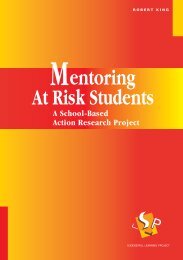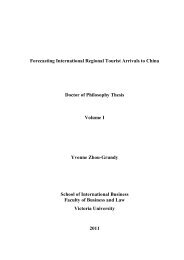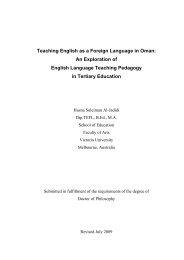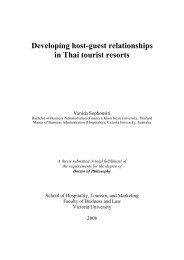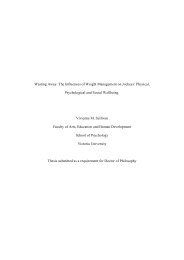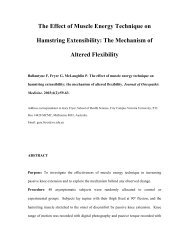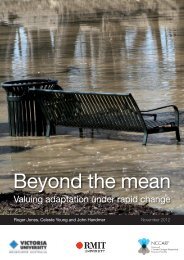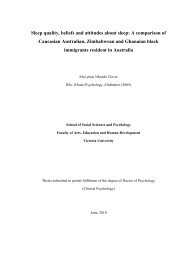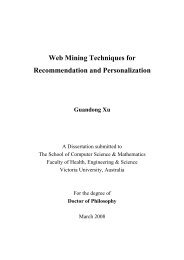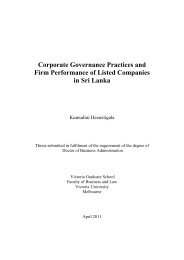Providing Education and Training for At Risk ... - Victoria University
Providing Education and Training for At Risk ... - Victoria University
Providing Education and Training for At Risk ... - Victoria University
- No tags were found...
You also want an ePaper? Increase the reach of your titles
YUMPU automatically turns print PDFs into web optimized ePapers that Google loves.
All States <strong>and</strong> Territories are encouraging the growth of vocational education in schools.Although approaches <strong>and</strong> programs vary, there is growing recognition that vocationalprograms should build on a strong general education <strong>and</strong> not limit students’ choices.The notion of an integrated approach to upper secondary curriculum has received strongsupport. This has been reflected in the report … The Role of Schools in the VocationalPreparation of Australia’s Senior Secondary Students [NBEET: 1994]. (p72-73)(emphasis added)In the late 1990s, these issues of retention, participation <strong>and</strong> integration are still with us. Theadded imperative of engaging the learning of those returning to studies, who are clearlyexperientially-enriched adults, yet perhaps resistant to traditional schooling, increases theurgency with which the main issues must be addressed.Another area which could be brought to bear here is the emerging field of enterprise education,especially in the OECD version, a ‘cross-curriculum’ approach, which emphasises anenterprising state of mind. Here, study, work <strong>and</strong> life in general are thought to benefit fromexperiences requiring the application of initiative <strong>and</strong> resourcefulness in increasingly complex<strong>and</strong> less structured activities (Curriculum Corporation 1995; OECD 1989; Patterson et al.1997). Such an approach would be congruent with the self-directive possibilities latent inyoung adults, rich in life’s experiences, who are contemplating returning to studies, whetherin a school or a community setting. Here, shop-front program provision could come closest tosome shop-front enterprise!Program design which is itself inclusive (as above), integrated into mainstream schooling, <strong>and</strong>which is challengingly provided in non-school settings, <strong>for</strong> those returning to studies, shouldbear in mind what is not compatible with such design. Cole, in the Schools <strong>and</strong> CurriculumUnit at VISE (1984: 69), cautions against ‘youth participation projects’ which:• are designed exclusively <strong>for</strong> the academically gifted or <strong>for</strong> those who are seen as beingacademically weak;• send large numbers of students into the community with little preparation <strong>and</strong> guidance;• draft students into activities over which they have little or no control;• engage students in trivial or demeaning work in a school, community or industry setting;• give a peer group or clique certain liberties <strong>and</strong> privileges because of its members’ seniorityor maturity;• consist of activities unsupported by committed <strong>and</strong> sympathetic adults;• provide experiences but <strong>for</strong>go reflection <strong>and</strong> evaluation procedures involving youth <strong>and</strong>other participants;• disqualify students from continuing with their <strong>for</strong>malised education.From these negatives, we can extract a set of descriptors <strong>for</strong> worthwhile program design. Thelast section identifies these, in the light of this Review as a whole.27




